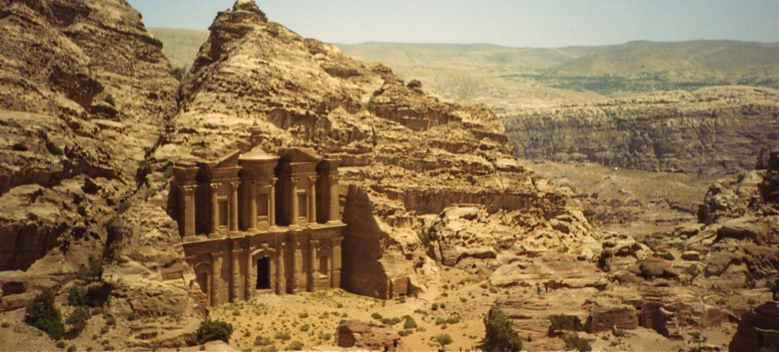Archaeology's Enemy Number One: Salt

The Monastery in Petra, Jordan
Charlie Phillips via flickr | http://bit.ly/1okC44d
Media rights: http://bit.ly/cGotEb
(Inside Science) -- The enemy of archaeology everywhere is salt. It destroys buildings, disassembles art works, and can turn ancient pottery into piles of dust.
How salt lays waste to these artifacts is well known, but scientists in Switzerland have monitored the process in a laboratory. Their observations could help preserve the buildings, art, and treasured relics of humanity.
The salts in question are not just sodium chloride, the salt on your dining room table or in the sea, but substances such as fluorides, sulfates, and acetates -- substances formed when acids and bases interact. It can affect sites in the desert or along the coast, or anywhere with high humidity, said Robert Flatt, professor of building materials at ETH Zurich, an engineering institute in Switzerland. Even the Sistine Chapel can be affected.
In places like Petra, the 2,300-year-old city carved in rocks in Jordan, the salt comes from the infrequent but intense rains. In Luxor, the site of ancient Egyptian city of Thebes, it comes from ground water infiltrated by the nearby Nile River. And it even rains in Luxor.
The process is simple: Salt, dissolved in water, gets into the pores of building material, and crystallizes. The crystallization of the salt breaks or crumbles the material around it. It’s often called weathering and can even affect concrete buildings because concrete contains gypsum, a sulfate.
Sometimes weathering is the result of a chemical reaction. For instance, sulfur dioxide, a pollutant in the air, can react with calcium carbonate in limestone, forming gypsum. Seawater spray can also weather buildings.
Sometimes, however, the salt intrusion is on a vaster scale. In the German town of Staufen, underground drilling caused underground water to move into a layer of earth containing calcium sulfate. The two substances combined to form gypsum, which expanded and raised the ground by almost an inch, cracking the ground and damaging buildings in the downtown area.
To watch the process of salt destruction, the researchers from ETH and Princeton University in New Jersey took small cubes of limestone and put them in a bath of sodium sulfate long enough for the salt to permeate pores in the stone. Then, they dried them out at high temperatures and repeated the cycle at a lower temperature. The salt crystallized during the drying process and dissolved into liquid again when it was back in the bath. Eventually, the bath became a supersaturated solution, meaning it held more salt than it would normally, making it more destructive.
The damage happened quickly. It is the cycles that eat up buildings, Flatt explained.
“With sodium sulfates, the damage happens during the wetting and it’s worse at low temperature. With sodium chloride, which would be typical in coastal regions, the damage happens during the drying and it would in principle be worse...at higher temperatures,” Flatt said.
Archeologists in the field aren’t the only ones facing salt damage. So do museums.
“A lot of times we’re dealing with ceramics,” said Lynn Grant, a senior conservator at the University of Pennsylvania Museum of Archaeology and Anthropology in Philadelphia. The salt comes from the ground in most places, and in the Mediterranean area, the soil contains carbonates that can form crusts on ceramics. These can be removed with acid baths.
Artifacts that contain other salts can be cleaned and saved. The traditional preservation method, she said, was a soak in purified water. Items that can't endure such a treatment must be kept at a steady humidity and temperature to prevent any remaining salt from doing further damage, particularly in places like Philadelphia which has high humidity in the summer and dry air in the winter.
Frescoes also are vulnerable. If they are not attached to a wall, they can be taken down and soaked in purified water, she said. If they are attached they can be treated with poultices, which are applied to the surface and absorb the salt crystals.
“The question is which does more damage, the salt or removing the painting,” Grant said.
The salt in wall paintings comes from the stone in the walls or from the paint itself. If it is in the walls, there is an almost infinite supply. If salt is removed from a painting, it will start reabsorbing more as soon as the painting is replaced on the wall.
Protecting buildings is an entirely different matter, Flatt said, although the chemistry is the same. No one knows for sure how to do it, or how much salt needs to be removed to protect buildings, although the Geneva research may lead to answers.
“It is very much on a case-by-case basis,” he said, often depending on the nature of the salt. Sometimes a poultice works. Some research is being done on organic polymers that would create a molecular film over the pores of the walls.
Sometimes a solution with additives can be sprayed on a building to dissolve the salt, which would then percolate outside the walls.
Flatt said his team would try to put what they learned in practice in the old city of Havana.
Update: the text has been modified to clarify a description of salt dissolved in water and to correct details regarding historical preservation methods. We regret the error and any confusion.

